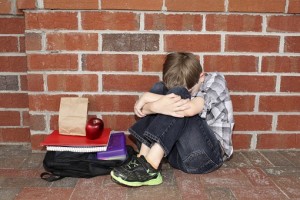 It’s an issue that affects almost all children in some way. In the first of a series of articles discussing ‘bullying’, IB World magazine investigates its effects, what adults and students can do to combat it, and how a school in Sweden has used the IB learner profile to help
It’s an issue that affects almost all children in some way. In the first of a series of articles discussing ‘bullying’, IB World magazine investigates its effects, what adults and students can do to combat it, and how a school in Sweden has used the IB learner profile to help
“Bullying is something that resonates with everyone,” says psychologist Catherine Bradshaw. “When I host training days on this issue and ask by a show of hands how many were involved in bullying as a child—either as the perpetrator, the target or had a friend who was involved—the vast majority of hands go up.”
A study of 40 developing countries, undertaken by the World Health Organization (WHO), showed that exposure to bullying ranged from 8.6 per cent to 45.2 per cent in boys and from 4.8 per cent to 35.8 per cent in girls. In the US, 28 per cent of students in grades 6-12 experience bullying. While 45 per cent of 13- to 18-year-olds have experienced bullying by the age of 18 in the UK, according to anti-bullying charity, Ditch the Label. Each year, 2.5 million UK teens encounter bullying.
But what exactly is bullying? How do we differentiate it from other types of problem behaviours that appear? Bradshaw, who is also a Professor and the Associate Dean for Research and Faculty Development at the Curry School of Education at the University of Virginia, US, says there are three core features within the definition of bullying, which was characterized by Swedish researcher Dan Olweus in the late 1980s. These allow us to identify if the behaviour requires adult intervention.
She says: “The first is aggressive behaviour that is intentional in nature. Secondly, it typically occurs in the context of a power imbalance, in terms of popularity or having a bigger network on Facebook, for example. The third is whether the behaviour is repeated over time.”
Bullying can occur in many different forms. It can be verbal and/or include physical or relational contact.
“The majority of bullying seems to be more verbal and in many cases relational, meaning threatening one’s social status within a group or excluding them to lower their power,” says Bradshaw.
Cyberbullying
 The abundance of social networking mobile apps, which encourage group chats and the sharing of photos, can be used as a driver for cyberbullying. “Some researchers call it electronic aggression,” explains Bradshaw. “Most students who are bullied online are also bullied in person. In many cases, it’s a continuation.”
The abundance of social networking mobile apps, which encourage group chats and the sharing of photos, can be used as a driver for cyberbullying. “Some researchers call it electronic aggression,” explains Bradshaw. “Most students who are bullied online are also bullied in person. In many cases, it’s a continuation.”
Although cyberbullying can happen anywhere, anytime, it’s the least common form of bullying, according to Bradshaw. However, there is research to suggest that it could be the most harmful as it often includes images, making it more real, personal and hurtful. “Images can be passed around more easily and become a permanent record. It’s near impossible to delete an image from everybody’s memory much less their device,” she says.
Bradshaw noted from several studies that while some people say being bullied made them stronger, for the majority it’s a hurtful experience. She says: “There is something about bullying that can be damaging.”
To help students, Bradshaw advises adults to encourage them to tap into personal resources.
We want to build inner strength in children so they can regulate their emotions, and learn how to deal with adversity as well as access interpersonal resources, such as who they can reach out to for help and support.
IB learner profile
To help tackle bullying, an IB World School in Sweden used the IB learner profile to frame and guide an anti-bullying programme. School counsellor, Dr Michael Lynch, and his team at Bladins International School of Malmö, won an IB 2013 Jeff Thompson Research Award to conduct a research project, entitled Evaluation of an IB-informed prevention approach to bullying with MYP students: Using a mixed-methods approach incorporating a quasi-experimental design within a Swedish IB school.
Lynch, who is also a lecturer at University of Gothenberg, in Sweden, says:
The IB learner profile attributes reflect the values of a true global citizen, a student who is considerate of others and at the same time honest with themselves. Integrating the profile into the study helped some students understand the attributes.
He surveyed MYP students and found that 25-27 per cent had experienced bullying in the last few months.
While our school has a clear policy on addressing bullying issues, it was clear that we were not meeting the needs of all our students. The programme we put together was our attempt to address this.
Teachers and the school counsellor decided to combine the IB learner profile attributes to create an anti-bullying programme. “Pairing the attributes, rather than having them separate, gives the programme greater coherence and strength,” explains Lynch.
The school paired the following IB learner profile attributes: knowledgeable and inquirer; thinker and balanced; communication and reflection; principled and open-minded; and caring and risk-taker. They then asked students questions such as ‘how does being a risk-taker inspire one to be more caring of others?’ and ‘how can being mindful contribute to one becoming more caring to oneself and others?’ The objective was to understand that caring for others can sometimes involve taking risks, and why being caring and mindful is important.
As part of the mixed-methods approach, only half of the students received intervention over the research period: “Comparing the groups allowed us to tentatively discuss any changes within the results,” says Lynch.
Four weeks later, there was an 11 per cent increase in the number of students who had not experienced bullying in the past couple of months, 13 per cent felt they had increased their number of friends, and 20 per cent felt that the teacher or mentor did more to counteract bullying. There was no notable change within the other group.
“While the results in this small study have to be interpreted with certain caution, it is promising to see that there was a desirable change in the students’ personal experiences of bullying,” says Lynch.
As a result of the programme, students now find it easier to identify bullying and know how to stop it. This indicates a need to promote the role of the bystander and encourage students to intervene and help when they recognize bullying.
Bradshaw says:
Helping out can include telling an adult, but as we get into adolescence there is an interest in getting teens to learn how to help each other – whether it is trying to stop the bullying or standing up for the student being targeted. But we don’t want students to respond in aggressive ways.
School-wide approach
Research suggests that all staff play a major role in raising awareness of bullying. The more staff involved in a programme, across all levels, the greater chance of successful intervention.
Bradshaw says: “All adults in the school setting need training about how to identify bullying, respond to it and be sensitive towards it.”
Adults should act immediately. Otherwise, students can feel disempowered, advises Bradshaw: “The perpetrator, who usually thinks their behaviour is justified in some way, will think that the adults don’t care. The target can get upset and develop a negative image whereby other people are condoning it and feel disconnected from others. If you do see students in conflict, separate them and address each separately.”
Safe learning environments
While bullying may be more common than is desirable, and some cases more severe than others, all incidents require intervention. “Many adults experienced bullying at some point in their lives and may have turned out OK. It’s very difficult to predict which children it’s not going to affect and for which it’s going to be very damaging,” says Bradshaw.
All schools should be thinking about bullying. It should be an international conversation. We should be providing all students with safe and supportive learning environments that are free from bullying.
Tell us how your school tackles bullying: email editor@ibo.org

